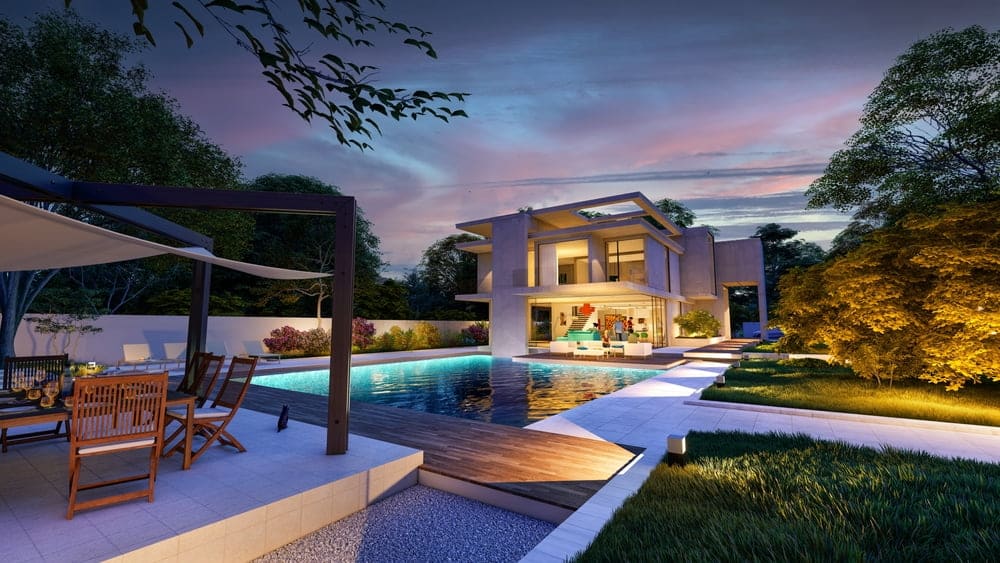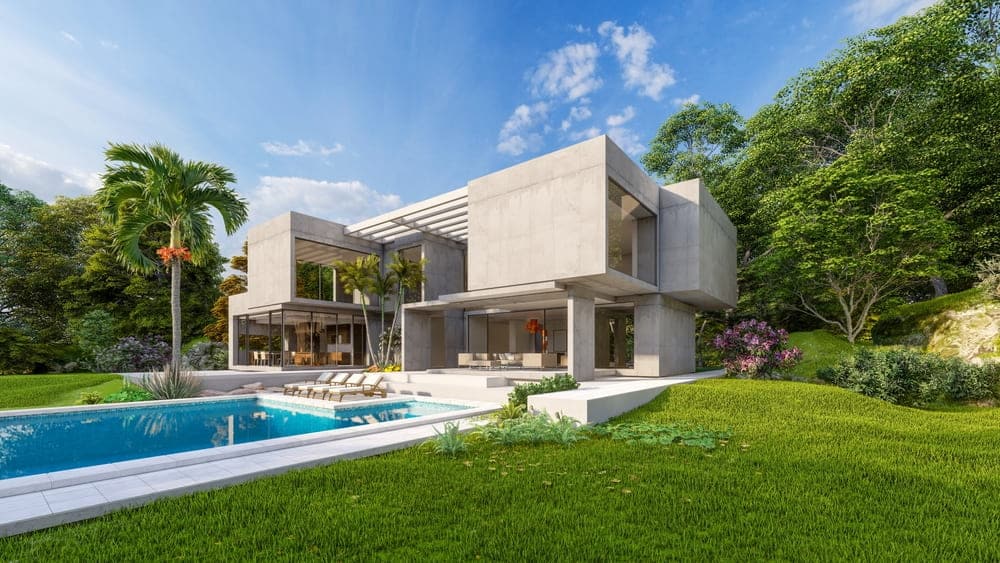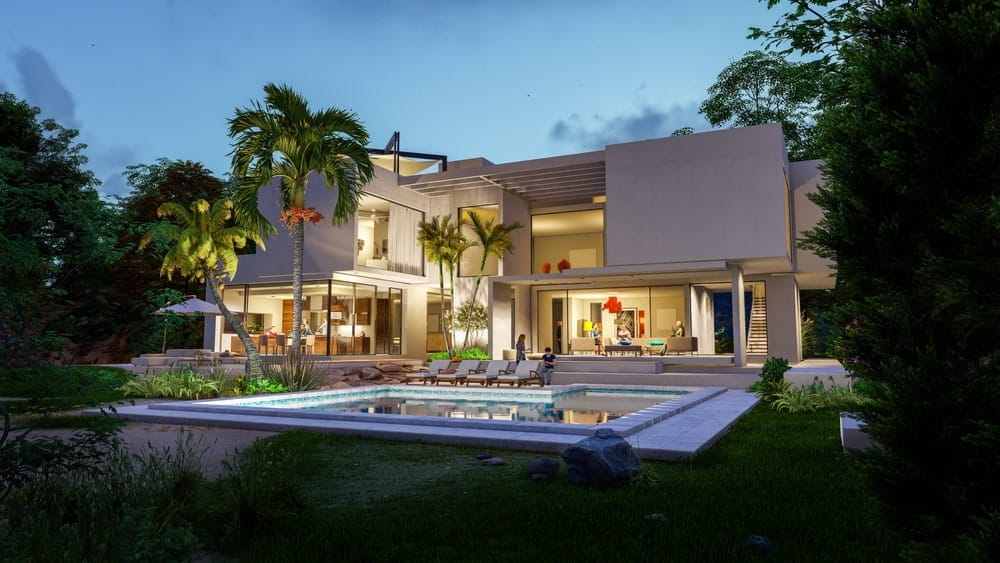
As environmentalism becomes more important to our everyday lives, sustainability is gaining more popularity everywhere, including in the landscaping market. Constantly maintaining your yard can be tiring, and sustainability can play a vital role in lessening that pain while giving back to the planet.
The average yard requires maintenance around once a week, which can get old fast when you have to do all the work. The typical yard is challenging to upkeep and may not be the best for the environment.
But what does it take for something to be sustainable? Can a landscape be sustainable and still appealing? Here’s how we create sustainable landscape designs that are still incredibly beautiful.
The Need-To-Know
In all honesty, sustainable landscape designs are not impossible or even that hard to create. Sustainability can be as simple as building a hardscape or switching to solar lighting. The most important thing to remember when considering sustainability is practicality and accessibility.
Not everyone wants to completely redo their yard, and that’s okay! That does not mean that you can’t renovate some parts of your landscape design, like switching out the grassy areas for some native plants, to make it more sustainable.
When you think about changing your yard, you need to start with the initial landscape design. Here are some questions to consider:
- What are you changing from the current design?
- What do you want without a shadow of a doubt?
- What can you do without?
These questions will help you understand what you want and can help you find a starting point.
This starting point is how we begin to create a sustainable landscape design. It helps us get there realistically. Sustainable changes do not have to break the bank and they also do not have to take weeks to get done. While some changes may be a little bigger, harder, and more time-consuming, plenty of ideas that favor sustainability can be done in under a day.
The How-To (Creating Sustainable Landscape Design)

A sustainable landscape design sounds perfect in theory, but carrying it out can seem a lot more challenging. What are the practical ways we can start taking steps in the right sustainable direction?
There are easy changes you can make, like adding rain barrels or composting bins, and then there are the bigger alterations, such as changing your lighting or the plants you grow. Whether you are out to make big or small changes, everyone has to start somewhere.
Here are a few simple suggestions that will build up to giant leaps for a sustainable yard.
#1. Think Native
Native plants and also native rocks are perfect for a nature-friendly space, and they also are much cheaper. It can seem unusual to focus on local flora, but it reaps massive benefits.
Native plants usually can live off the natural rainfall, lessening the need for watering. They bloom throughout all the different seasons, and they have evolved to the point in which they are uniquely set to live in the specific conditions of where they grow.
Native plants are less likely to die or need constant maintenance to keep from wilting. They are also welcoming to local insects and animals. Local plants dig their roots deep enough to survive whatever the weather throws at them.
Utilizing native plants presents many benefits, from saving the water bill to creating a long-lasting welcoming space for humans. It is essential to consider the care it will take to continuously protect non-native plants as compared to the little effort needed to keep up with native ones.
#2. Harvest the Rain
Harvesting may seem like a weird way to put it, but rain is a natural source of water that can replenish itself. Simple barrels or troughs can be instrumental in collecting the rainwater from your gutters.
The overflow from gutters and storm drains plays a large part in unnatural erosion. Collecting the rain prevents it from over-hydrating the plants and allows you to store the clean water for use in your landscape later on.
Any amount of rain will eventually lead to erosion. It may be due to the inability of storm drains to keep up or from bad planning about the area, but either way, erosion is not ideal for more than just the immediate land.
Creating a safe way to deal with rainfall may prove wise in the long run. Proper draining plans help you understand what is most likely to be affected in worst-case scenarios like a hurricane.
#3. Less (Maintenance) Can Be More
Grass looks impressive and mainstream, but it may not be the way to go. In the summer, grass has to be mowed, usually about once a week, which can be a total time-killer. A sustainable landscape design can be the key to lessening the amount of time you have to spend on your lawn.
A key feature of sustainability is lowering the amount of maintenance needed to keep the area in check because that all ties into energy, water-use, and gas emissions. A high-maintenance yard is a red flag for environmentalists. It will need to be watered, mowed, weeded, and kept up often, whereas a low-maintenance yard is often left to its own devices and still looks good.
Low maintenance does not mean abolishing everything that requires some effort, but it does mean making conscious decisions that ease a high-maintenance yard into a low-maintenance one. To effectively do this, consider starting small by changing the watering system, plant beds, or even the bushes that take too much time to trim.
Mulching is an excellent, low-maintenance way to improve your garden. It protects the plants and reduces weeds but doesn’t require you to maintain it. You could also opt for a rock yard to get a clean, attractive landscape that requires no mowing or watering and little to no weeding.
A sustainable lifestyle and yard can run itself while also helping the environment. Consider utilizing a composting bin. The trash is already in your possession, but now you can put it somewhere you can use it to help the environment and ourselves.
#4. Rock It Out
Rocks can be instrumental in creating a sustainable, low-maintenance hardscape. You can find rocks on your property or you can buy them. The entire area does not need full coverage of stone, but some rock accents are a nice touch.
A rock garden or even a rock wall are easy ways to include rock in a sustainable landscape design. One of the best parts of using stones is that they naturally help against erosion and water overflow.
Rocks are sometimes synonymous with ugly, but that is not the truth. All it takes is the right design for stone to build a unique design that forms a welcoming space we never want to leave.
Rocks provide better coverage than concrete. Concrete is just a slab of cement that does nothing to better sustainability or elevate the space. Rocks can do it all while still being more sustainable.
#5. Solar Lighting
Solar energy was a big topic a few years ago, but since the talk has died away. While solar energy can be expensive and seems challenging to integrate, the truth is that solar lighting can be as simple as switching out the porch or pathway lights to harvest the sun’s energy.
Whether outside all night or only there till the kids fall asleep, outdoor lighting is essential to see the people we want to be around. Solar lighting can be a big step, so it may make more sense to take a few little steps to get there. LED lighting can be the smooth first step to more sustainable lighting.
Solar lights are a quick fix that radically helps keep sustainability up and maintenance costs down. Pathway lighting or string solar lights are not bulky and do not require huge panels! Solar lighting does not have to be ugly to be functional.
#6. Think Outside The Box
Despite many available low-cost options, you can’t fully interchange some things. A sustainable space is often a unique one. Reclaiming and thrifting pieces to create is one practical way to practice sustainability.
Even if you still have grass to mow, you can create less waste by using products more beneficial for the environment. Electric engines are more widely available, and you can use them in place of classic gasoline devices. From leaf blowers to weed trimmers, electric options are an easy way to keep your grass neat and protect the environment.
The easiest way to cultivate a natural-looking yard is to leave it natural! Some things can be left as they are. Those fortunate enough to have large acreage or even just a little bit of land may have natural beauty such as brooks, creeks, woods, and wildflowers. If this is the case for you, let them grow wildly to create the perfect sustainable landscape design.
Try gardening. Growing fruits and vegetables requires work and dedication but is rewarding when you eat the first bite of something you grew yourself. Not everyone has a green thumb or space for a full garden, but there are plenty of herbs and succulents that pretty much grow on their own. You simply need to plant them in a pot.
Final Thoughts

Finding unique ways to be nature-friendly and happy with your space is the key to creating a sustainable landscape design. You’ll reach sustainability when a bunch of small changes build up into larger ones, and together they create an eco-friendly space.
A sustainable yard may seem out of reach, but with the right help, anything is possible. The first step is to examine what is already there so you know where to start when planning a more sustainable landscape.
Our team can provide you with ideas and help you create a sustainable landscape design. Fill out our simple online form or contact ALD today. We can’t wait to meet you and your yard.
